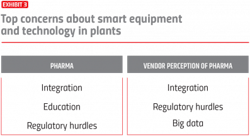Smart Pharma Survey results: Pharma’s digital prowess put to the test
Pharma Manufacturing’s fifth annual Smart Pharma survey separately asked drug manufacturers and equipment and services vendors* their thoughts on the pharma industry’s digital maturity.
While results from our 2019 survey generated concern that the industry’s enthusiasm for the digital “revolution” was waning, last year’s survey results — fielded 6 months into the pandemic — were brimming with digital positivity.
With the pandemic persisting, what has become of pharma’s digital journey?
As pharma professionals around the globe wait to see what post-pandemic industry will look like (and when it will arrive), this year’s mixed bag of survey results reflect that sentiment.
For the purposes of this survey, “vendors” are defined as companies who offer pharma processing equipment, lab equipment, controls or software, as well as contract researching, consulting or related services. There were 36 vendor responses. “Pharma manufacturers” are defined as those who manufacture pharma or biopharma drugs, make APIs or excipients or offer contract manufacturing services. There were 43 manufacturer responses.
The positives
Pharma companies are proactively choosing to automate.
Just over 88% of pharma manufacturers — the highest percentage in survey history — said they believe their company would choose to automate processes if given the option.
The pandemic has propelled change.
More than half of pharma manufacturers surveyed said that the COVID pandemic has led to more automation and less personnel on the plant floor; increased interest in digitalizing the supply chain and better integrating partners; and an increased use of technology to collect and analyze data in real-time.
The negatives
Less than 80% of pharma manufacturers can decisively say the pharma workforce is becoming more comfortable with automation. This is trending way down from last year’s 93%.
Are we going backwards, or has it just been a tough year? As companies work through the kinks of rapidly deployed digital solutions, frustration is inevitable.
This year, 27% of equipment vendors claim that when their pharma customers are designing/upgrading their facilities, digitization is “rarely” part of the discussion.
While the majority of pharma manufacturers ay digitalization is part of their facility design discussions (Exhibit 4), pharma vendors don't quite agree.
And according to ISPE’s Pharma 4.0 Special Interest Group, which has been working since 2015 to translate how Industry 4.0 impacts the pharma industry’s unique requirements, has stated that while smart factory transformations are not a “must,” they provide a competitive advantage to the extent that missing out could be a business risk.
What changed:
More pharma manufacturers and equipment vendors felt that the burden of pushing the drug industry to automate belongs to equipment manufacturers and software providers.
According to the survey results, 38% of pharma manufactures and 54% of equipment vendors said that equipment manufacturers and software providers should be proactively leading the charge by offering innovative products and education.One of the many issues the pandemic has highlighted is the importance of reliable, trusted supply partners. Pharma’s core competency is discovering innovative treatments, so an increased reliance of partners to provide the necessary tools could free up the industry to do what it does best.
What stayed the same:
Half of pharma companies are still at the starting gate when it comes to progress on digital transformation/IIoT initiatives.
This finding (Exhibit 2) is consistent with the past five years of pharma survey results.
To see how pharma compares on a broader industrial stage, we can look to Smart Industry’s most recent State of Initiative report, which compiles resulted from surveyed professionals from across manufacturing, processing and related industries. When asked about their company’s progress on digital transformation initiatives, only about 10% purported to still be at the “starting gate.”
And yet, the variability in survey answers can partially be attributed to the lack of a standard, unified method for evaluating a company’s digital transformation progress. In short, everyone defines digital success differently.
Pharma’s top concerns surrounding smart equipment and technology in plants haven’t changed since 2018.
Integrated, defined as, “difficulty integrating new technology with existing lines or equipment” has held the number one spot for both pharma manufacturers and equipment vendors. (Exhibit 3)
This persistent and pervasive hurdle stems from the many legacy systems in operation on the pharma plant floor that lack the capability needed to connect to high level automation systems or devices as well the need to connect technologies from different suppliers to develop fully integrated processes.
Regulatory hurdles, specifically a lack of regulatory buy-in or understanding of new processes continue to be cited as an obstacle by both pharma manufacturers and equipment vendors.
This comes in spite of considerable strides made by the U.S. Food and Drug Administration towards shaking the agency’s reputation as innovation blockers.
During this year's Parenteral Drug Association annual meeting, Jeffrey Baker, deputy director, Office of Biotechnology Products, Center for Drug Evaluation and Research challenged the pharma industry’s wiliness to modernize in the manufacturing space. According to Baker, although more than 90% of FDA submissions are supplements to Biologics License Applications, very few, if any, reflect modernization or deployment of new manufacturing technologies.
Baker pointed out that despite the fact that regulators are often blamed, the reality is that the FDA has encouraged development of advanced manufacturing technologies for 20 years through strategic plans, working groups, partnerships and programs.
The pharma industry relies on balancing of risk and in the digital sense, it means deciding what risks are worth taking. The most successful digital strategies have often challenged the historical understanding of regulatory policy.
Top image courtesy of Alexander Sinn via Unsplash.com.
About the Author
Karen P. Langhauser
Chief Content Director, Pharma Manufacturing
Karen currently serves as Pharma Manufacturing's chief content director.
Now having dedicated her entire career to b2b journalism, Karen got her start writing for Food Manufacturing magazine. She made the decision to trade food for drugs in 2013, when she joined Putman Media as the digital content manager for Pharma Manufacturing, later taking the helm on the brand in 2016.
As an award-winning journalist with 20+ years experience writing in the manufacturing space, Karen passionately believes that b2b content does not have to suck. As the content director, her ongoing mission has been to keep Pharma Manufacturing's editorial look, tone and content fresh and accessible.
Karen graduated with honors from Bucknell University, where she majored in English and played Division 1 softball for the Bison. Happily living in NJ's famed Asbury Park, Karen is a retired Garden State Rollergirl, known to the roller derby community as the 'Predator-in-Chief.'




